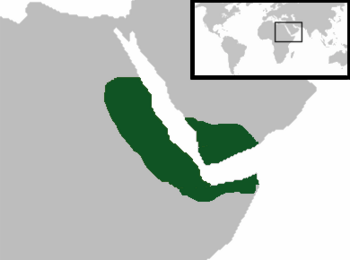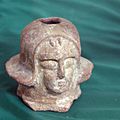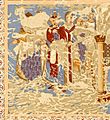Kingdom of Aksum facts for kids
Quick facts for kids
Aksumite Empire
መንግስቲ ኣኽሱም (Ge'ez)
|
|||||||||||||||||||
|---|---|---|---|---|---|---|---|---|---|---|---|---|---|---|---|---|---|---|---|
| c. 100 AD – c. 940 AD | |||||||||||||||||||

All territories ever part of the Aksumite Empire
|
|||||||||||||||||||
| Capital | Aksum | ||||||||||||||||||
| Common languages | Ge'ez | ||||||||||||||||||
| Religion | Arabian polytheism (pre-Aksumite to 4th century) Judaism (before c. 330) Christianity (Ethiopian Orthodox Tewahedo Church; after c. 330) |
||||||||||||||||||
| Government | Monarchy | ||||||||||||||||||
| Negūs | |||||||||||||||||||
|
• c. 100
|
Za Haqala (first known) | ||||||||||||||||||
|
• c. 940
|
Dil Na'od (last) | ||||||||||||||||||
| Historical era | Classical Antiquity to Early Middle Ages | ||||||||||||||||||
|
• Established
|
c. 100 AD | ||||||||||||||||||
|
• Conquest by Gudit
|
c. 960 AD | ||||||||||||||||||
| Area | |||||||||||||||||||
| 350 | 1,250,000 km2 (480,000 sq mi) | ||||||||||||||||||
| Currency | AU, AR, AE units | ||||||||||||||||||
|
|||||||||||||||||||
| Today part of | Eritrea Ethiopia Djibouti Somalia Yemen Sudan Saudi Arabia Egypt |
||||||||||||||||||
| This article contains Ethiopic text. Without the correct software, you may see question marks, boxes, or other symbols instead of Ethiopic characters. |
The Kingdom of Aksum (Ge'ez: መንግስቲ ኣኽሱም), also known as the Aksumite Empire, was an ancient kingdom. It was located in what is now Eritrea and the Tigray Region of northern Ethiopia. The Aksumite Emperors were powerful rulers. They called themselves "King of Kings." They also ruled over many other places like Himyar, Saba, and Kush.
This kingdom lasted for a long time, from about 80 BC to 825 AD. It started to grow from an earlier Iron Age period around the 4th century BC. By the 1st century AD, it became a very important kingdom.
Contents
Aksum's Rise to Power
A Hub for Trade
Aksum became a major player in trade between the Roman Empire and Ancient India. Its rulers even made their own Aksumite currency to make trading easier. This helped Aksum become very wealthy and influential.
Expanding Influence
The Aksumite kingdom also grew powerful over the Kingdom of Kush, which was getting weaker. Aksum often got involved in the politics of kingdoms on the Arabian Peninsula. They even took control of the Himyarite Kingdom there. A famous prophet named Mani (who lived around 274 AD) thought Aksum was one of the four most powerful empires in the world at that time. The others were Persia, Rome, and China.
Culture and Religion
Giant Stone Monuments
The Aksumites built huge stone pillars called stelae. These tall structures were used for religious reasons before Christianity came to the kingdom. One of these granite pillars is incredibly tall, reaching about 90 feet! It's one of the largest stone structures of its kind in the world.
The Arrival of Christianity
Under King Ezana (who ruled from about 320 to 360 AD), Aksum adopted Christianity. This was a big change for the kingdom. In the 7th century, early Muslims from Mecca found safety in Aksum. They were escaping persecution and traveled to the kingdom. This journey is known in Islamic history as the First Hijra.
Legacy of Aksum
The Ancient Capital
The kingdom's old capital city, also called Axum, is now a town in the Tigray Region of northern Ethiopia. The Kingdom of Aksum used the name "Ethiopia" as early as the 4th century.
Legends and Stories
Many traditions say that Axum is the resting place of the Ark of the Covenant. It is also believed to be the home of the famous Queen of Sheba. These stories add to the rich history and mystery of the Aksumite kingdom.
Images for kids
-
The Ezana Stone records negus Ezana's conversion to Christianity and his subjugation of various peoples nearby, including Meroë
-
The economically important northern Silk Road and southern Spice (Eastern) trade routes. The sea routes around the horn of Africa and the Indian sub-continent made Aksum an important trading port for nearly a millennium.
-
An Ethiopian illuminated Evangelist portrait of Mark the Evangelist, from the Ethiopian Garima Gospels, 6th century, Kingdom of Aksum, influenced by Eastern Roman art
-
Coins of king Endybis, 227–235 AD. British Museum. The left one reads ΑΞΩΜΙΤΩ BICIΔΑΧΥ, possily "man of Dachu, (king) of Axumites", linguistically mixed(?). The right one reads in Greek ΕΝΔΥΒΙC ΒΑCΙΛΕΥC, "King Endybis".
-
Silver coin of Ezana.
-
Ruins of the Dungur palace in Axum.
See also
 In Spanish: Reino de Axum para niños
In Spanish: Reino de Axum para niños

































